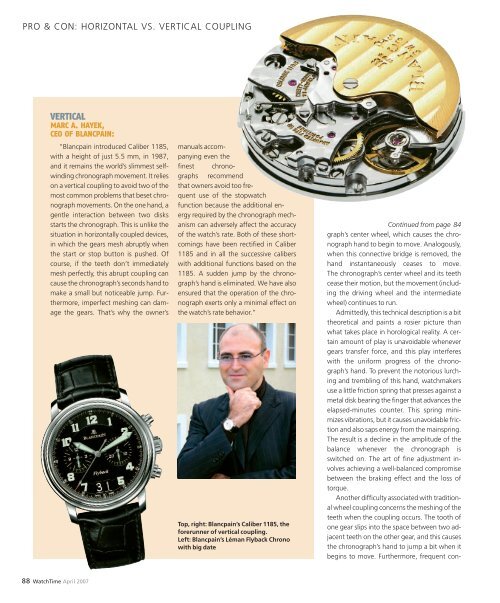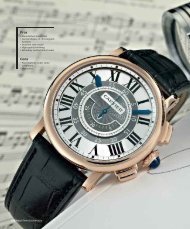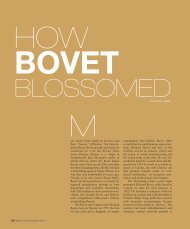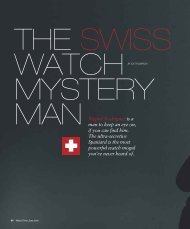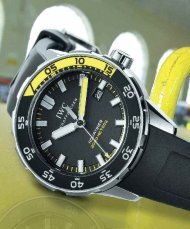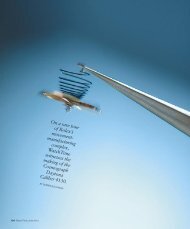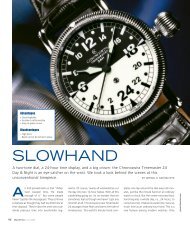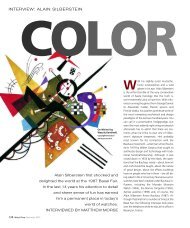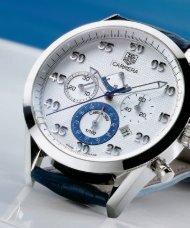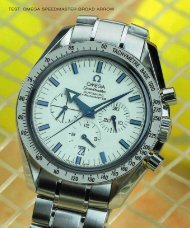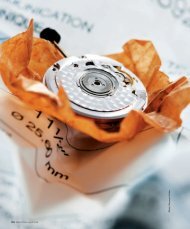pro & con: horizontal vs. vertical coupling - WatchTime
pro & con: horizontal vs. vertical coupling - WatchTime
pro & con: horizontal vs. vertical coupling - WatchTime
Create successful ePaper yourself
Turn your PDF publications into a flip-book with our unique Google optimized e-Paper software.
PRO & CON: HORIZONTAL VS. VERTICAL COUPLINGVERTICALMARC A. HAYEK,CEO OF BLANCPAIN:“Blancpain introduced Caliber 1185,with a height of just 5.5 mm, in 1987,and it remains the world’s slimmest selfwindingchronograph movement. It relieson a <strong>vertical</strong> <strong>coupling</strong> to avoid two of themost common <strong>pro</strong>blems that beset chronographmovements. On the one hand, agentle interaction between two disksstarts the chronograph. This is unlike thesituation in <strong>horizontal</strong>ly coupled devices,in which the gears mesh abruptly whenthe start or stop button is pushed. Ofcourse, if the teeth don’t immediatelymesh perfectly, this abrupt <strong>coupling</strong> cancause the chronograph’s se<strong>con</strong>ds hand tomake a small but noticeable jump. Furthermore,imperfect meshing can damagethe gears. That’s why the owner’smanuals accompanyingeven thefinest chronographsrecommendthat owners avoid too frequentuse of the stopwatchfunction because the additional energyrequired by the chronograph mechanismcan adversely affect the accuracyof the watch’s rate. Both of these shortcomingshave been rectified in Caliber1185 and in all the successive caliberswith additional functions based on the1185. A sudden jump by the chronograph’shand is eliminated. We have alsoensured that the operation of the chronographexerts only a minimal effect onthe watch’s rate behavior.”Top, right: Blancpain’s Caliber 1185, theforerunner of <strong>vertical</strong> <strong>coupling</strong>.Left: Blancpain’s Léman Flyback Chronowith big dateContinued from page 84graph’s center wheel, which causes the chronographhand to begin to move. Analogously,when this <strong>con</strong>nective bridge is removed, thehand instantaneously ceases to move.The chronograph’s center wheel and its teethcease their motion, but the movement (includingthe driving wheel and the intermediatewheel) <strong>con</strong>tinues to run.Admittedly, this technical description is a bittheoretical and paints a rosier picture thanwhat takes place in horological reality. A certainamount of play is unavoidable whenevergears transfer force, and this play interfereswith the uniform <strong>pro</strong>gress of the chronograph’shand. To prevent the notorious lurchingand trembling of this hand, watchmakersuse a little friction spring that presses against ametal disk bearing the finger that advances theelapsed-minutes counter. This spring minimizesvibrations, but it causes unavoidable frictionand also saps energy from the mainspring.The result is a decline in the amplitude of thebalance whenever the chronograph isswitched on. The art of fine adjustment involvesachieving a well-balanced com<strong>pro</strong>misebetween the braking effect and the loss oftorque.Another difficulty associated with traditionalwheel <strong>coupling</strong> <strong>con</strong>cerns the meshing of theteeth when the <strong>coupling</strong> occurs. The tooth ofone gear slips into the space between two adjacentteeth on the other gear, and this causesthe chronograph’s hand to jump a bit when itbegins to move. Furthermore, frequent <strong>con</strong>-88 <strong>WatchTime</strong> April 2007


